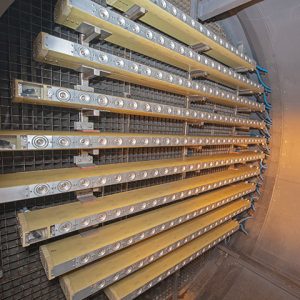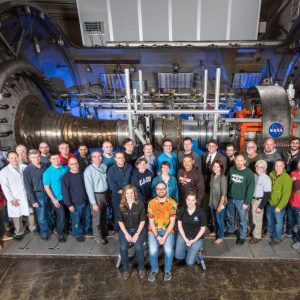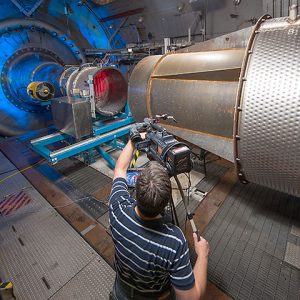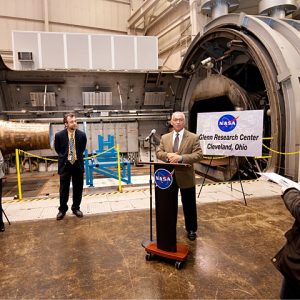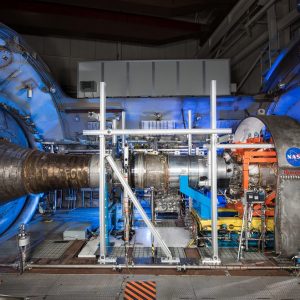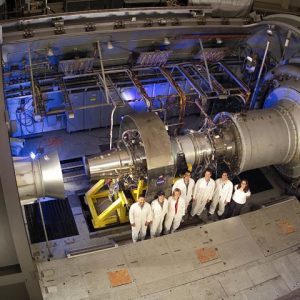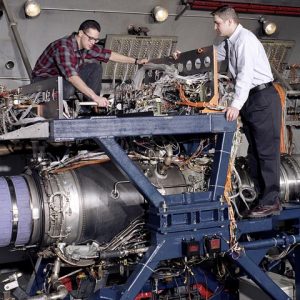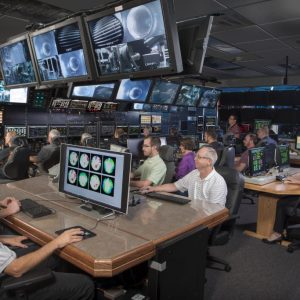Propulsion Systems Laboratory
The Propulsion Systems Laboratory (PSL) is NASA’s only ground-based test facility that provides true flight simulation for experimental research on air-breathing propulsion systems. The PSL has recently added the capability to simulate clouds of ice crystals and liquid water droplets.
Facility Overview
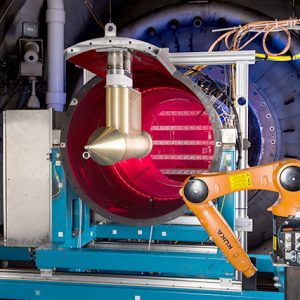
The Propulsion Systems Laboratory (PSL) complex provides world-class test and evaluation capabilities in support of NASA’s research and testing mission and charter. Built in the early 1970s, PSL has hosted a number of unique programs that have furthered engine research technologies.
Altitudes to 90,000 ft and Mach numbers to 3.0 in one cell and 6.0 in the other can be simulated continuously. Engine airflow is available to 480 lb/s at an inlet pressure of 55 psia or to 380 lb/s at 165 psia. Inlet temperature control is also available. Real-time display and post-test data reduction are available for all measured and calculated parameters.
The PSL is a highly versatile test facility developed to suit the one-of-a-kind testing common to NASA aeronautics research and testing programs. This versatility allows quick reaction to changes in program direction, as well as complete flexibility to pursue new goals that arise unexpectedly from ongoing experimental research.
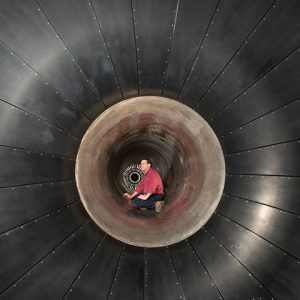
Unique concepts in altitude engine testing have been pioneered and perfected in the PSL, such as multiaxis thrust measurement, vectored and reverse exhaust gas collection, infrared imaging at altitude, aeroelastic measurements, transient pressure and/or temperature distortion simulation, and flight transient simulation. Recognizing innovation, other test organizations have asked to share PSL’s expertise.
Quick Facts
The Propulsion Systems Laboratory is NASA’s only ground-based test facility that can provide true flight simulation for experimental research on air-breathing propulsion systems. Altitudes to 90,000 ft and Mach numbers to 3.0 in one cell and 6.0 in the other can be simulated continuously.
| Name | Propulsion Systems Laboratory |
|---|---|
| Mach Number | 0 – 3.0 (PSL-3)0 – 4.0 (PSL-4) |
| Test Section | 38-ft long and 24-ft wide in diameter |
| Altitude | 0 to 90,000 ft |
| Mass Flow | Inlet air flow up to 480 lbs/sec Exhaust air flow up to 750 lbs/sec |
- Take a virtual tour of our Propulsion Systems Laboratory.
- The PSL has a new one-of-a-kind Jet Engine Icing capability.
- This continuous flow altitude simulation facility is equipped to conduct full-scale and component testing for base research, advanced aircraft, space transportation, general aviation propulsion, and hypersonic propulsion.
- The PSL has supported Turbine-Based Combined Cycle Systems (TBCC), and tested the engines used to power the following aircraft: SR–71, F–5E/–5F, F–5A/B, C–9, F–15, F–16, EF–111A, A–10A, B52, F/A–18, F–22, and ECLIPSE.
- Unique concepts in altitude engine testing have been pioneered and perfected in the PSL, such as multi-axis thrust measurement, vectored and reverse exhaust gas collection, infrared imaging at altitude, transient pressure and/or temperature distortion simulation, and flight transient simulation.
Capabilities
The Propulsion Systems Laboratory is NASA’s only ground-based test facility that can provide true flight simulation for experimental research on air-breathing propulsion systems.
Characteristics and Performance
- Altitude simulation to 90,000 ft
- Two engine test cells: PSL-3 and PSL-4
- Mach Number Range:
- PSL-3: to 3.0
- PSL-4: to 4.0
- PSL-4: Freejet Mach No. with auxiliary heater – to 6.0
- Tied to central compressed air and exhaust systems
- Thrust measurement: 50,000 lbf horizontal axis, 15,000 lbf vertical and lateral axes
- Simulate clouds of ice crystals and liquid water droplets at altitudes of up to 90,000 ft and speeds of up to mach 0.8
Combustion Air System
- Main Supply
- 480 lbs/sec @ ambient temperature and 55 psia
- 380 lbs/sec @ ambient temperature and 165 psia
- 240 lbs/sec @ 1100°F and 165 psia
- 380 lbs/sec @ -40°F and 25 psia (PSL-3)
- 30 lbs/sec @ -90°F and 25 psia (PSL-4)
- Cooling Air Supply
- 100 lbs/sec @ ambient temperature and 55 to 165 psia
Altitude Exhaust System
- Altitude Range: sea level standard to 90,000 ft
- Mass Flow: up to 750 lbs/sec
Support Systems
- Jet Fuel System: Two 25,000 gallon tanks supporting various types of fuel (JET-A, JP-4, JP-5, JP-8)
- Natural Gas system: 10 inch header @ 50 psig
- Gaseous Hydrogen System: 1 lb/sec @ 600 psig — 3 lbs/sec @ 1100 psig, maximum pressure is 2400 psig
- Gaseous Nitrogen System: 132,000 scf @ 2400 psig
- Hydraulic System: 100 gpm @ 3000 psig
- High Pressure Hydraulic System: 100 gpm @ 6000 psig
Data Acquisition
- Steady State Acquisition
COBRA (Collect Observe Broadcast Record and Analyze) is NASA Glenn Research Center (GRC)’s standardized low speed (12.5 to 1000 samples per second per channel) data system. The system uses commercial off the shelf (COTS) hardware and operating systems coupled with specialized data acquisition and application hardware/software modules. It has a flexible and scalable design that utilizes a distributed network architecture approach. This design allows the attachment of measurement devices from a wide range of vendors. This approach allows the system to evolve over time, permits the latest technology to be used that meets NASA GRC’s measurement requirements, and provides the environment for the best measurement methods to be applied.- Universal Data Server
- Runs data processing engine (DPE) which collects, aggregates, and records the data
- Performs engineering unit conversions and complex calculations
- Data distributed to clients in near real time while acquisition and recording continue
- Data Displays
- Run the DataViewer software
- Receives data from COBRA network via the UDS
- Allows user to view real time data in numerical and graphical representations
- Synchronized Time Generator
- Provides Network Time Protocol (NTP), Precision Time Protocol (PTP), Inter Range Instrumentation Group (IRIG) signals to the data acquisition systems and nodes in the COBRA system
- Synchronized to GPS/USNO via the GRC central time source
- Reprocessing Data Export Server
- Allows user to reprocess data (correct calculations, add calculations, change coefficients, etc.)
- Exports data to files
- Acquisitions Devices
- Modular and scalable with support for wide variety of measurement devices:
- Analog Input System
- Electromechanical Scanning Pressure – Digitally temperature compensated electronically scanned pressure scanner, known as NetScanners
- Digital Temperature Scanners – Scanivalve DTS system
- Frequency Inputs
- Digital I/O
- Avionics Interfaces
- Modular and scalable with support for wide variety of measurement devices:
- Universal Data Server
- Transient Data Acquisition
The dynamic data systems provide multi-channel high speed digitized acquisition of rapidly changing cyclic or non-periodic impulse type events.The system consists of:- Programmable filter/amplifying front end
- 24 bit sigma delta ADC with anti-aliasing filter
- Counter channels and math channels also available
- Data transfer in near real time available by request
- Custom displays
- Various sampling rates for differing bandwidth needs.
Contact
Propulsion Systems Laboratory
Facility Manager: Alicia Graham
216-433-8062
Alicia.Graham@nasa.gov
Test Facility Management Branch
Branch Chief: Michael S. McVetta
216-433-2832
michael.s.mcvetta@nasa.gov
Using Our Facilities
NASA’s Glenn Research Center provides ground test facilities to industry, government, and academia. If you are considering testing in one of our facilities or would like further information about a specific facility or capability, please let us know.
Did you test in one of our facilities? Let us know about your experience by participating in our customer facility evaluation survey.

